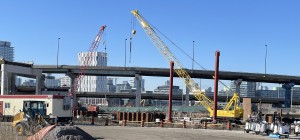The (billions of) dollars and sense of the Gardiner East
Toronto Star, Feb 3, 2023
Tents sheltered under the Gardiner Expressway offer a scene stark with irony — a city that can afford to send motorists hurtling through the sky on a motorway but can’t house its most vulnerable residents.
In the context of a major budget hole, and shortfalls in funding for social programs and climate action, it’s time for Toronto city hall to provide an up-to-date account of the monies being poured into its waterfront expressway, and the revenues being foregone.

Gardiner East – a deteriorated portion has been demolished but the city plan remains to rebuild the massive on ramps (background) to the DVP.
Last week a city hall committee approved the 2023 operating and capital budgets, including $2 billion for the “rehabilitation” and rebuilding of the Gardiner. The expressway, named after Metro Toronto’s first mayor — known as “Big Daddy” for his authoritarian style — has been deteriorating for years and gulping down many millions of dollars for repairs. The eastern Gardiner, which was in the worst shape, could simply have been torn down and connected to the Don Valley Parkway at grade, as city staff had recommended. Instead, in June 2015, Mayor John Tory and a slim majority of councillors approved a plan to rebuild the eastern Gardiner, a project dominated by the mammoth cost of a new, elevated link between the two expressways.
The staff recommendation would also have freed up more waterfront lands that could be sold at lucrative prices, then generate property taxes for the city. The estimated construction savings and new revenues would likely put the city over $1 billion ahead — and help fill annual budget shortfalls that this year amount to $1.4 billion (subject to federal and provincial bailouts). Instead, the Gardiner will continue, for decades to come, to put its hand in our pockets.
The mayor simply insists that the Gardiner East decision has been made, but since it’s our money he’s talking about, we have a right to know the actual cost and foregone revenues, especially when contracts for the rebuild have yet to be signed.
Tory’s devotion to the Gardiner is increasingly curious given changed circumstances — not only the budget gap but new transit projects that will soon need customers, not competition from cars.
Unlike 2015, the city today has a number of shovel-in-the ground transit projects, including the Ontario Line (running parallel to parts of the Gardiner and DVP), the Scarborough subway, and two LRTs, along with improved Lakeshore GO train service.